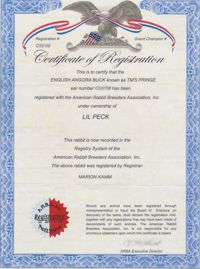The EZ Tatt directions also say that immediately after doing the tattoo, to dab it with a damp paper towel. I haven’t done that. Because of my previous experience with clamp tattoos, I put a glob of vaseline over the tattooed area, rub it a little, then wipe it with a paper towel. I like to think that the vaseline seals in the ink. After wiping it with the paper towel, I can check the tattoo for gaps in the lines, and touch them up if necessary.
The EZ Tatt directions say to put hemorrhoid ointment or cream on the tattoo after it is done. That seems to do a good job of soothing the ear and preventing swelling. The next day, if a tattoo area looks a bit irritated, I smooth some antibiotic ointment over it.
When I put a bunny back in its cage after tattooing, I like to give it a handful of hay to distract it and hopefully prevent it from scratching at its ear. Sometimes an Angora rabbit will nibble off its ear tassels after receiving a tattoo. They will reach up with their paws and pull the ear down to where they can reach it with their mouth. For that reason, I prefer to give tattoos before the bunnies’ ear furnishings are very developed.
At what ages do you like to tattoo your rabbits? I like to tattoo at 9-12 weeks of age. If you wait longer, then you have a larger ear surface to work on, but the rabbit might be less cooperative, and an Angora might chew off the tassels of the tattooed ear. If you wait longer, then if the rabbit has weak ear carriage, the tattooing will be less likely to trigger a lopped ear. A benefit of winter litters is that because of the cold, we are less likely to get lopped ears.
A couple of weeks ago, the ARBA licensed Registrar, Marion Kamm came over to register rabbits for me. Because I had several to register, I knew it would be easier to have her come to my home than to try to do it at a show.
I’ve seen some folks refer to their rabbits as “papered,” when what they really mean is that they have pedigrees for the rabbits. Pedigrees are charts that display a rabbit’s ancestry, and should include the rabbit’s sire and dam, and the sire and dam of each parent. I like to include the great-grandparents on my pedigrees also. It is the responsibility of a rabbit breeder to maintain their own records and pedigrees. A pedigree for an individual animal should list its name, ear number, registration number (if applicable), grand champion number (if applicable), breed, sex, birthdate, color, weight, and the names of the breeder and the owner. For the animals listed in the ancestry chart of the pedigree, the section for each ancestor should include its name, ear number, registration and grand champion numbers if applicable, and color and weight.
To register a rabbit, you must be a member of the American Rabbit Breeders Association (ARBA); the rabbit must have a complete pedigree; and the rabbit must not have any disqualifying faults. The Registrar examines the rabbit to check it for faults. Disqualifications are items such as mismatching claw colors, incorrect weight, missing claws or toes, a crooked tail, and unaccepted colors.
After examining the rabbit, the Registrar tattoos the rabbit’s right ear, and fills out the registration form. She will copy the rabbit’s pedigree onto the form, and this is when it becomes convenient if the rabbit’s parents were registered previously, because the Registrar then needs only to write down the registration numbers of the sire and dam, and does not have to fill out any more of the pedigree. When the parents are registered, ARBA already has their information in its database.
It takes a few weeks for the forms to get processed at the ARBA office, and then you receive a beautiful certificate of registration for your rabbit. In some cases, there may be a special seal affixed to a registration, to designate:
 Red means both parents are registered.
Red means both parents are registered.
Red and White – parents and grandparents have been registered.
Red, White, & Blue – all animals on the registration certificate were registered.
Gold – all ancestors on the registration certificate were grand champions. (I bet Betty Chu has a few of these!)
Registration adds value to a rabbit, because it signifies that at the time of registration, the rabbit had no disqualifying faults and was a good representative of its breed. In addition, a rabbit cannot receive a Grand Champion certificate unless first registered. To maintain a registered herd is commendable. Yet, there are some serious, respected fanciers who do not get their rabbits registered. One of the reasons is because it can be difficult to track down a Registrar who has the time to do it. The ARBA show rules require that every sanctioned show have a Registrar on duty. However, the Registrar may be too busy to get to your rabbit, so that is why I like to arrange an appointment with a Registrar at a more convenient time. Here is the list of ARBA registrars. ARBA licensed rabbit show judges can also register rabbits.